Tips and Techniques to Improve Forecast Accuracy
Every business, big or small, bases most of its production, marketing and distribution decisions based on the sales forecast. Inaccuracy of the sales forecast can misguide the business’s efforts and take a toll on its finances. So, here are some tips on how to improve forecast accuracy and fine-tune your sales forecasts.
Choose the Right Forecasting Technique
The first and the foremost thing that will determine as well as affect the accuracy of your sales forecasts, is the forecasting technique you choose. There are more than a dozen forecasting methods to choose from – judgmental bootstrapping, Delphi method, conjoint analysis, extrapolation, structured analogies, etc. Your choice will depend on a lot of factors such as the type of data available, expected changes, recent changes affecting sales, internal policies and procedures, etc. Choosing the right forecasting technique can improve the accuracy by 15 to 40 percent. The remaining tips that follow will be effective only if you have made the right decision here.
Determine the Length of the Sales Cycle
Sales cycle length takes into account the time gap between the time the product is ready and the time when the customer actually purchases the product. Sales life cycle can range from a day to more than a year, and it’s important that this cycle length is taken into account when preparing sales forecasts. This will help in ensuring that you have the right volumes reaching the market at the right time.
Deploy Multiple Data Sources
Don’t just rely on the past year’s sales data to make the forecasts. Get hold of the sales records for the past three to ten years and use these sales cycles for making your sales forecasts. Also, where possible you should try and include other sources such as demand forecasts and industry forecasts. There are numerous surveys conducted by trade organizations and market research companies, which can be used to fine-tune the sales forecasts. In addition to all this, you should try to analyze data at different levels of the supply chain – warehouse, distributors, retailers and finally the customers.
Clean the Data for Exceptions and Distortions
You must identify and clean out data related to exceptional circumstances that lead to variances in the past sales. Did your competitor do something unusual that affected your sales? Were sales volumes affected by some natural, social or political event? Did disruptions in the distribution system lead to a drop in sales? Did sales surge because of promotional schemes or sales incentives? These are just a few cases where some exceptional situation or factor may have affected the sales. What we’re trying to identify here are one-time variables, which are not expected to reoccur during the period for which the forecast is being made.
Accommodate Market Changes
The market is dynamic, and you cannot expect it to behave the same way it did over the past year. You need to keep track of how the market and economic situation has changed and is likely to change over the next year. Let’s take an example of a business that’s sells home furniture. If the interest rates on home loans have dropped down, it’s likely that more people would be buying homes and accordingly the company can expect an increased sale of its furniture. When analyzing market changes, you must also consider the impact of market changes on factors affecting your sales, whether directly or indirectly.
Make Room for Compelling Future Events
Are there any significant events scheduled over the next year that can affect your sales? If there are, you need to make room for the expected changes in sales, because of these events. For instance, if you’re into manufacturing sports goods or you’re into tourism and your country has planned to host an international sports event, you should keep provisions in the sales forecast to meet seasonable or additional demand arising because of the event.
Dissect the Forecast to Lower Levels
Sales forecasting is incomplete if it’s focused only on the total sales and not on how sales or demand varies for each size or variant of the product. A company making men’s vests doesn’t just need to know how many vests it can expect to sell over the next year; rather it needs to find out how many vests will be needed in each size or color. So once you have an aggregate forecast ready, you need to dissect it to lower levels and make individual forecasts for different variants.
Setup a Formal Forecasting System
To improve forecast accuracy, you cannot have it as a random activity or as once a year activity. You need to have a regular schedule and proper policies and procedures laid down for conducting sales forecasts. The presentation of the forecast should follow a specific format that is easy for every concerned person to use and understand. Accountability and responsibility should be clearly defined. How, when and by whom the forecast needs to be reviewed, updated or modified should be clearly specified.
Adopt the Conservative Approach to Tackle Uncertainty
Uncertainties are inevitable, and when confronted by uncertainties the best approach is to make conservative sales forecasts. The conservative approach suggests that you should make your forecasts as close to the base rate or average as possible. This will help keep the forecast errors on the lower side.
Using some or all of these tips will certainly help improve forecast accuracy. However, more important than developing an accurate forecast is to constantly monitor and evaluate it in the light of the latest happenings and trends. Even the best of sales forecasts can fall to the ground if they’re not reassessed periodically.
